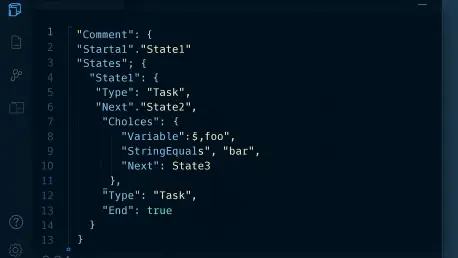What if a single tool could transform the grueling task of managing serverless workflows into a streamlined, frustration-free process, offering developers a way to escape the endless toggling between tools and sifting through logs? Picture a developer, bogged down by these challenges, suddenly finding a way to test and debug right within their favorite coding environment. The AWS Step Functions extension for Visual Studio Code (VSCode) has emerged as a beacon of hope for those wrestling with the complexities of AWS workflows. This innovation isn’t just a minor update—it’s a radical shift that promises to redefine efficiency for developers worldwide.
The significance of this tool lies in its potential to bridge a critical gap in serverless development. For years, professionals have struggled with inefficiencies that slow down projects and inflate costs. This extension offers a direct solution by embedding powerful testing and debugging capabilities into a widely used IDE, slashing development time and reducing reliance on external platforms. Its impact is already being felt across the developer community, signaling a turning point for how serverless architectures are built and maintained on AWS.
Revolutionizing Serverless Workflows: Why This Tool Stands Out
The arrival of this VSCode extension marks a pivotal moment for serverless technology. It addresses a long-standing need for a more integrated and intuitive way to handle AWS Step Functions, a service that orchestrates complex workflows but often burdens developers with cumbersome processes. By embedding workflow management directly into the coding environment, the tool eliminates unnecessary steps and empowers users to focus on innovation rather than logistics.
Beyond mere convenience, the extension represents a broader trend in cloud computing toward developer-centric solutions. As serverless adoption continues to soar—with studies indicating a 30% annual growth in usage since 2025—tools that simplify orchestration are becoming indispensable. This particular advancement stands out by offering a seamless bridge between local testing and cloud deployment, a feature that could redefine best practices in the field.
The Struggles with AWS Step Functions Before the Breakthrough
Prior to this release, working with AWS Step Functions often felt like navigating a maze with no map. Developers were forced to juggle multiple interfaces, switching between the AWS Console and local setups just to make a small adjustment. This disjointed workflow not only wasted time but also introduced errors that were hard to trace without extensive manual effort.
Debugging posed an even greater challenge, as it relied heavily on combing through CloudWatch logs—a process that could take hours for a single issue. Making matters worse, even tiny changes demanded full deployments to AWS, racking up costs and stretching project timelines. The inability to test individual workflow states without running everything added yet another layer of inefficiency, leaving many developers exasperated by the lack of granular control.
Transformative Features That Redefine Development
The extension tackles these pain points with a suite of features designed to streamline every aspect of workflow creation. Visualization within the IDE allows developers to map out and interact with Step Functions directly, removing the need to hop between tools. This alone saves significant time, especially for those managing intricate workflows with multiple dependencies.
Local execution stands as another game-changing capability, enabling testing without constant uploads to AWS. This not only cuts down on expenses but also accelerates iteration cycles. Add to that live debugging, which provides real-time error tracking, and the state-by-state testing feature, which lets users validate specific components with custom inputs. For instance, in a workflow involving AWS Lambda functions with error handling, isolating a failure scenario for testing now takes minutes instead of hours, showcasing the practical impact of these advancements.
Community Reactions and Lingering Concerns
Feedback from the developer community underscores the extension’s immediate value, with many hailing it as a critical upgrade. A software engineer recently noted in an online discussion, “State-by-state testing has been a lifesaver for debugging complex workflows—it’s like finally having a magnifying glass after years of squinting.” Such sentiments reflect a widespread appreciation for how this tool addresses long-standing frustrations.
However, not all reactions are unequivocally positive. A notable critique centers on the extension’s limitation to VSCode, excluding users of other popular IDEs like IntelliJ or Eclipse. Another developer voiced a common concern in a forum post: “It’s a fantastic step forward, but my team is split between IDEs—why isn’t this available everywhere?” This exclusivity raises questions about accessibility, especially since AWS has extended support for services like Lambda to multiple platforms, hinting at a potential oversight in the rollout strategy.
Maximizing the Tool and Pushing for Wider Reach
For those already using VSCode, adopting this extension is a straightforward process with immediate benefits. Installation from the marketplace, followed by linking AWS credentials, sets the stage for seamless integration. Leveraging visualization to sketch out workflows and using local execution for iterative testing can drastically improve efficiency. Focusing on state-specific validation with custom data further refines critical components, ensuring robust error handling before deployment.
For developers on other IDEs, the path forward involves advocacy rather than immediate adoption. Engaging in community forums or submitting feedback to AWS can help highlight the demand for broader compatibility. Sharing specific use cases—such as enterprise environments where IntelliJ dominates—can strengthen the case for expanding support. This dual approach ensures that the benefits of this innovation are either harnessed now or pushed toward inclusivity for all.
In reflecting on this transformative tool, it’s clear that the AWS Step Functions extension for VSCode has carved a new path for serverless development. Its features address deep-rooted inefficiencies, empowering developers with unprecedented control and speed. Yet, the limitation to a single IDE has left a segment of the community on the sidelines, sparking a necessary conversation about accessibility. Moving forward, the focus has shifted to bridging that gap—expanding support to other platforms has become a logical next step to maximize impact. Encouraging AWS to prioritize inclusivity promises to ensure that every developer, regardless of their chosen tools, can tap into this revolutionary advancement.









